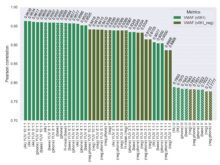While many AI-based codecs are still making their first appearance in white papers, often with …
Read More »
March 17, 2025
Why Broadcasters Are Turning to Server-Side Multi-View Solutions
In a recent conversation with Jan Ozer from the Streaming Learning Center, Marc Todd, Founder and CE…
February 13, 2025
Deep Render AI Codec Running in FFmpeg and VLC
AI-based video compression has been discussed in research for years, but practical implementations a…
December 24, 2024
Comparing Fixed GOPs to Variable GOPs with I-Frames at Scene Changes
I first encountered the line, “Anything worth doing is worth overdoing,” in the Robert H…
October 15, 2024
There are no codec comparisons. There are only codec implementation comparisons.
I was reminded of this recently as I prepared for a talk on AV1 readiness at the upcoming United Clo…
August 18, 2024
The Reality of Codec Adoption in Six Pictures
Most people reading this post want new codecs to succeed as soon as possible, and I do as well. But …
Recent Posts
-
Ultra-Low Latency Video Control – An Interview with Jean-Baptiste Kempf of Kyber
At Mile High Video 2025, I sat down with Jean-Baptiste Kempf (JB), founder of Kyber …
Read More » -
Deep Render AI Codec Running in FFmpeg and VLC
-
What’s the Best Setting for x265 Two-Pass Encoding?
-
How Thread Count Impacts Video Encoding Quality, Throughput, and Cost
-
Announcing Free Course on Controlling the AMD MA35D with FFmpeg
-
How AdCurate Helps Publishers Improve Ad Quality and Boost Revenue
In this conversation, Jan Ozer from the Streaming Learning Center interviews Gabe Thomas, VP of …
Read More » -
Bitmovin Video Developer Report Reveals Streaming in 2025: Incremental Growth Over Innovation
-
Call for Contributions| ACM Mile-High Video 2025
-
Meet Open Source Video Downloader YT-DLP
-
Protected: LinkedIn Live: How to Nail for Your First Event
-
VMAF, SSIM, and Color Spaces: Getting the Metrics Right
So there I was, having dinner on a Saturday night date night with my wife… …
Read More » -
Updated Lessons for Video Quality Metrics Course
-
Free “Must-Have” Applications for Video Engineers
-
Additions and Updates to Video Quality Metrics Course
-
SVT-AV1 and Libaom Tune for PSNR by Default
 Streaming Learning Center Where Streaming Professionals Learn to Excel
Streaming Learning Center Where Streaming Professionals Learn to Excel

















